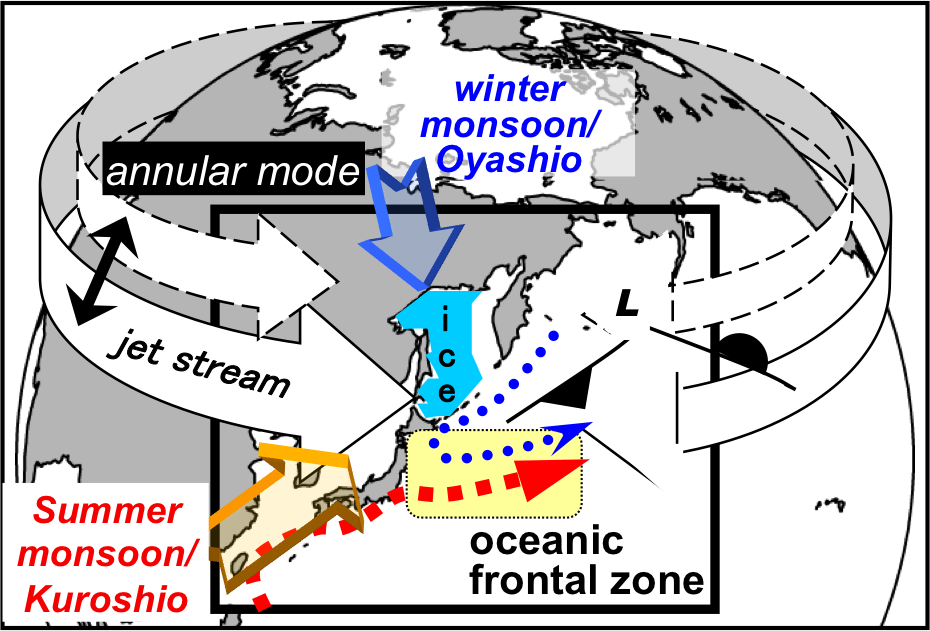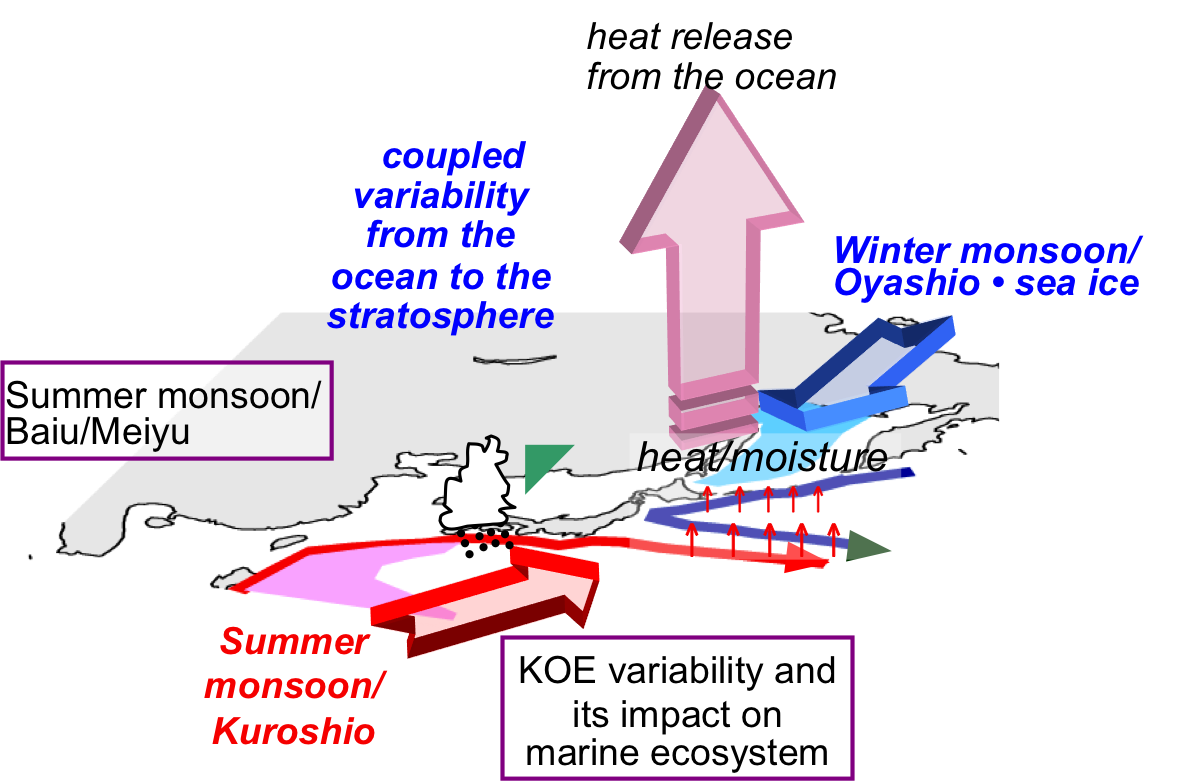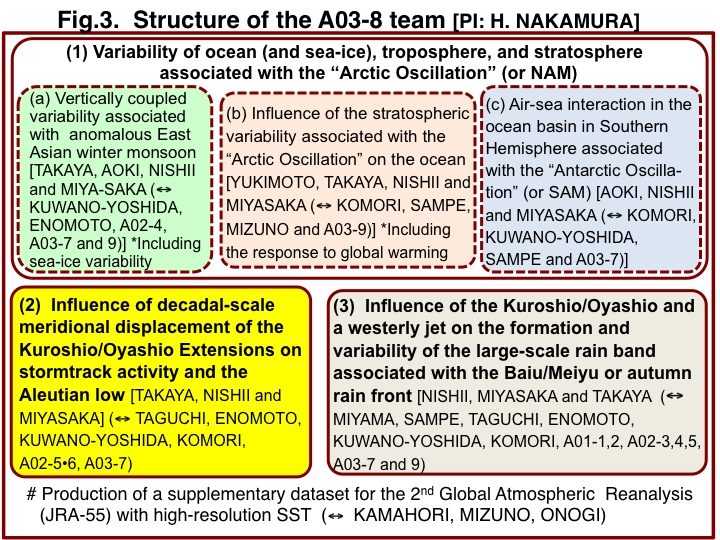Vertically coupled variability in the the atmosphere-ocean-ice system around Monsoon Asia
| A03-8. Vertically coupled variability in the the atmosphere-ocean-ice system around Monsoon Asia | |
|---|---|
| PI | Hisashi NAKAMURA# (Prof., Univ. Tokyo) |
| Members | Shigeru AOKI* (Assoc. Prof., Hokkaido Univ), Seiji YUKIMOTO# (GM, MRI), Koutarou TAKAYA# (Assoc. Prof., Kyoto Sangyo Univ.) |
| Adjunct members | Toru MIYAMA*, Nobumasa KOMORI*, Akira KUWANO-YOSHIDA# (Researcher, JAMSTEC), Takeshi ENOMOTO# (Assoc. Prof., Kyoto Univ.), Takeaki SAMPE# (Assoc. Prof., Aizu Univ.), Hirotaka KAMAHORI# (GM, MRI), Ryo MIZUTA# (Reseacher, MRI), Kazuaki NISHII# (Res. Assoc., Univ. Tokyo), Hiroki TOKINAGA# (Assoc. Prof., Kyoto Univ.), Yu KOSAKA#(Project Researcher ,Univ. Tokyo) |
| PD | Takafumi MIYASAKA# (Univ. Tokyo) |
JAMSTEC: Japan Agency for Marine-Earth Science and Technology
MRI: Meteorological Research Institute, Japan Meteorological Agency
[Doctoral degree:*Oceanography, #Meteorology]
Through analysis of satellite and atmospheric circulation datasets and numerical experiments with climate models on the Earth Simulator with horizontal resolution sufficiently high for resolving oceanic frontal structure, we aim to clarify various phenomenological aspects and (thermo-) dynamical mechanisms of large-scale tropospheric circulation and its variability coupled vertically with the ocean, sea-ice and the stratosphere, which are forced by vigorous air-sea interactions in the western North Pacific in association with heat and moisture release from the ocean and by the pronounced land-sea thermal contrast under the influence of the East Asian monsoon and heat transport by the Kuroshio and Oyashio Currents. Under close collaborations with other programs, we are conducting comprehensive investigations on the specific research topics described below.
- (i). We investigate the influence of vigorous air-sea interactions that occur around midlatitude oceanic frontal zones, including the confluent region of the Kuroshio and Oyashio east of Japan, upon the global-scale atmospheric circulation, including the maintenance and variability of midlatitude westerly jet streams, such as the “Arctic Oscillation” or “Northern Hemisphere annular mode (NAM)”, by maintaining and changing atmospheric eddy activity. We also investigate how these air-sea interactions and their modulations can contribute to the maintenance and low-frequency variability of the sea-surface temperature (SST) gradient across the frontal zones. Our ultimate goal is to clarify dynamical and thermo-dynamical processes that are involved in the aforementioned phenomena and processes and thereby establish our new interpretation of the atmospheric general circulation. We will utilize forecast/sensitivity experiments with and without in-situ observations that will be obtained during our intensive observational campaigns in the Kuroshio Extension. [All members of A03-8, in collaborations with main programs A02-5, 6, A03-7 and supplementary programs]
- (ii). We are going to assess how the characteristics of variability of midlatitude jet streams, manifested, for example, as the “Arctic Oscillation” (or NAM) and “Antarctic Oscillation” (or Southern Hemisphere annular mode: SAM), will possibly change under the global warming and how the associated variability in ocean currents and thermal structure will act to change the latitude and intensity of the major oceanic frontal zones. We will also assess what feedbacks will in turn be exerted by those changes in those frontal zones on the characteristics of the atmospheric circulation and its variability. Conducted through comparison between high-resolution climate model outputs on the Earth Simulator with various climate models used for the 4th Assessment Report of IPCC, most of which are unable to reproduce oceanic frontal structure, our assessments will offer some insight into the future climate changes, especially on the possible role of the oceanic frontal zones and their changes. [YUKIMOTO, NAKAMURA, AOKI, MIZUTA,TAKAYA, NISHII, MIYASAKA]
- (iii). We explore any possibility that anomalous heat release from the sea surface associated with the variability not only in SST but also ice/snow cover over the extratropical western North Pacific and Far East can influence the stratosphere by changing the tropospheric circulation. We also investigate how the variability in the stratospheric circulation can in turn influence the extratropical ocean and snow/ice cover by changing the tropospheric circulation, through, for example, comparing the stratosphere/troposphere coupled variability associated with the “Antarctic Oscillation” (or SAM). [NAKAMURA, AOKI, TAKAYA, TAGUCHI, KOMORI, NISHII, in collaboration with main program A03-9]
- (iv). We aim to clarify specific processes through which the midlatitude oceanic fronts around Japan are involved in the maintenance and low-frequency variability of the subtropical jet stream that accompanies the Baiu/Meiyu and autumn rain fronts. We also aim to assess the relative importance of the influence of the maritime monsoon activity over the western North Pacific and how oceanic processes can impact the particular monsoon activity. [NAKAMURA, MIYAMA, KUWANO-YOSHIDA, KOMORI, TAGUCHI, NISHII, MIYASAKA and SAMPE, in collaboration with main programs A02-4, 5]
※ In collaboration with the Meteorological Research Institute (MRI) and the Climate Prediction Division of the Japan Meteorological Agency (JMA), we plan to produce a supplementary dataset for the 2nd Stage Global Atmospheric Reanalysis (JRA-55), where SST data assigned at the lower boundary used for the standard product (1958-2012) with 1° horizontal resolution based on in-situ observations (COBE) are replaced with satellite-measured data with resolution of 0.25°after 1985 (MGDSST). If compared with the standard product, this supplementary atmospheric data set will be useful for identifying the impacts of SST fronts and/or meanders of ocean currents on the atmosphere.

Fig. 1 : Coupled System in Large-Scale.

Fig. 2 : "Hot Spot in Climate System" : Air-Sea Interaction under the East-Asian Monsoon.


